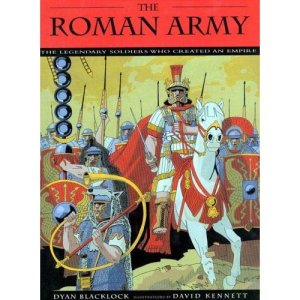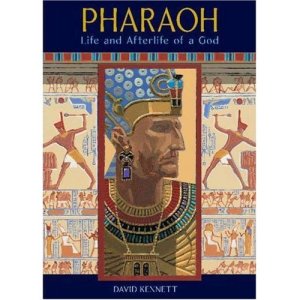 David Kennett is an Australian artist with a strikingly original illustration style. His historical drawings are an arresting mix of light and dark, impressionistic depictions of individuals and groups, and fascinating historical detail. His first book, on The Roman Army (subtitled The Legendary Soldiers Who Created an Empire) was published in 2004. Just this month, his second book, Pharaoh: Life and Afterlife of a God has been released. Each is 48 pages, hardback, full color, 8.5″ x 11″ format.
David Kennett is an Australian artist with a strikingly original illustration style. His historical drawings are an arresting mix of light and dark, impressionistic depictions of individuals and groups, and fascinating historical detail. His first book, on The Roman Army (subtitled The Legendary Soldiers Who Created an Empire) was published in 2004. Just this month, his second book, Pharaoh: Life and Afterlife of a God has been released. Each is 48 pages, hardback, full color, 8.5″ x 11″ format.
The Roman Army goes well beyond the standard depiction of the legionary. The inside flyleaves include detailed drawings of 28 “Enemies of Rome” mounted, and on foot. The text and interior illustrations make an compelling case that the Roman soldier (and his equipment, training, supplies, camps, and support corps) were responsible for the rise of Rome as the most powerful nation on earth.
There are detailed illustrations of officers, enlisted men, and auxiliaries. There is a full page devoted to the standard equipment of a legionary. Roman engineering abilities – especially their skill at building bridges, roads and camps is carefully portrayed. The heavy weapons, battle tactics, and siege engines of the Roman army all get full treatment.
The final 2-page spread shows a Roman triumph making it’s way through the forum. The Roman Army is a 48 page hardback, and sells for $17.95.
The text is written for upper-elementary readers through junior high, but even your older students will find the information quite interesting and useful as part of a study of Rome.
 Kennett’s second book, Pharaoh, is equally stunning. The dark tones of his drawings depicting the interior decoration of Egyptian tombs contrast sharply with the brighter colors (yellows, blues, & greens) of the scenes set in Egyptian cities and temples.
Kennett’s second book, Pharaoh, is equally stunning. The dark tones of his drawings depicting the interior decoration of Egyptian tombs contrast sharply with the brighter colors (yellows, blues, & greens) of the scenes set in Egyptian cities and temples.
Pharaoh, as Kennett depicts him, is an imposing and intimidating figure – whether seated on the golden throne, decorated with hieroglyphs and lion’s heads, or standing on a leopard-skin rug holding his staff and glowering. The text focuses on the New Kingdom pharaohs, Seti I and Ramesses II. Their elaborate tombs were prepared (and hidden) in man-made caves carved into the rock floor of the Valley of the Kings.
Ramesses is shown in his roles as priest at the great temple to Amun at Karnak, as the overseer and organizer of Egyptian agriculture in the flood-zone of the Nile valley, as the merchant-prince who controls the import and export of Egyptian goods, and as the commander in chief of the Egyptian army – leading his division of chariots across the desert.
One of the most stunning illustrations is a two-page spread showing the great temple to Ramesses carved into the cliffside above the Nile at Abu Simbel. But Kennett shows us, not the faded sandstone colossi that are still to be seen, but the bright, red-and-white painted figures of pharaoh with a colorful procession of chariots arriving to pay him tribute.
Kennett’s drawings do an excellent job of helping us to imagine what ancient Egypt was really like. The imagines are arresting, and it makes it easy for us to understand why the Greeks and the Romans were so impressed. It also helps us to understand the impact of the Exodus as Moses led his people out of the wealth and comfort of Egypt into the desert and wilderness of Sinai.
The Roman Army is $17.95. Pharaoh is $18.95. Each can be ordered directly from Greenleaf Press.
– Rob Shearer
Director, Schaeffer Study Center
Publisher, Greenleaf Press